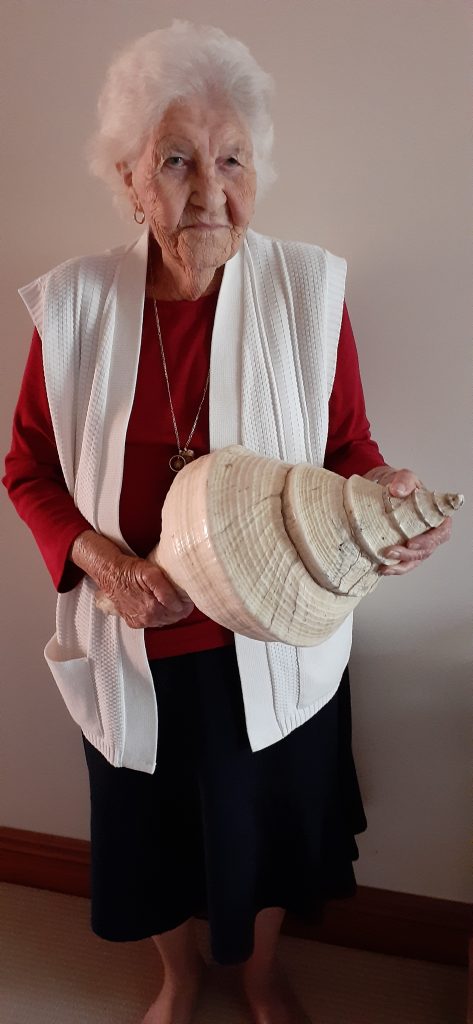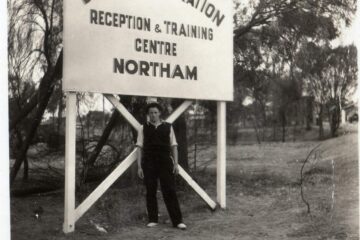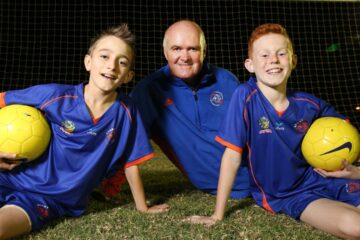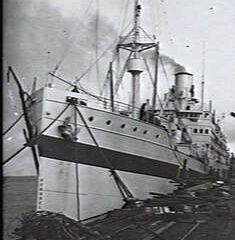Different from most Dutch migrants, Nies Lankamp was not born in the Netherlands. She was born in Teluk Bayur in North Eastern Borneo as Nies Landman. Her father, Gerard Landman, worked there as machinist on the coal transport ships of the Koninklijke Pakketvaart Maatschappij (KPM). Teluk Bayur is inland, connected by a river to the coast. It is about 200 km southwest of Tarakan Island.
Teluk Bayur was part of the Dutch colonial system and big enough to have a school, and that is where Nies went to a Dutch system primary school. In 1942, just as she had finished that school, the Japanese occupation put all the Dutch of Teluk Bayur into a camp. From there they were moved twice to other camps, all in Borneo. The camp years were not easy and there was no opportunity for further schooling.
Their camp was liberated in August of 1945, and the Landman family, consisting of mother Erna, father Gerard, five boys and four girls, were sent from Borneo to Australia for one year of recuperation. They first spent two months in Brisbane, which they liked, but then moved to Melbourne because her oldest brother was there in the Marines. Nies was almost 16 now and wasn’t interested in joining 12-yr olds in a first grade of High School.
After one year in Australia, the family was to go to Netherlands, but they had disliked the cold in Melbourne (not helped by a strike of fuel deliveries), and they knew that Netherlands was much colder, so they opted to stay in the region. Her father took a job in Manokwari, New Guinea, where they stayed seven years, until a future in New Guinea was becoming doubtful. Most of her brothers and sisters had also moved to Manokwari.
Nies had gone to work in New Guinea, where, in spite of not having received any high school education, she found an office job. She also found a husband, Benny Lankamp, who was born in Malang, Java, to a Dutch father and an Indonesian mother. Benny was a professional in the Dutch New Guinea Army.
In 1952, the money value was cut to half, but they were told that if they went to Netherlands, they would get it back there. So, in spite of their dislike of cold weather, most of the family migrated back to Netherlands and settled in Uitgeest, between Heemskerk and Alkmaar. Benny moved to Netherlands with them. Nies found a job as a seamstress at an atelier and Benny was now in the Dutch Army. Some of her brothers and sisters got jobs in other parts of Netherlands, but two brothers stayed in New Guinea.
Nies and Benny got married in 1957 in Uitgeest, and Nies continued working for eight years, until her children arrived. Both her son and daughter were born in Netherlands. Her father and mother both died within a few years of arriving in Netherlands, and her brothers and one sister decided to emigrate to Australia. The two brothers that had stayed in New Guinea were already living in Queensland.
Nies and Benny wanted to join them in Brisbane where most of the siblings lived, but the Australian Government had a problem with Benny’s ancestry. He was considered an Asian, which were not admitted under the white Australia policy. This policy was not renounced till 1973, but over the preceding ten years the restrictions were gradually relaxed and in 1969 Nies, Benny and their two children arrived in Australia by plane.
They had to pay in full for their visas, plane fare and other migration costs, so upon arrival in Brisbane they went to live in a caravan in the garden of Nies’ brother in Acacia Ridge. Nies went to work at Inghams chook factory, while Benny found a job as a welder with Thiess Brothers where he worked for for 20 years.
They rented a house in Acacia Ridge and after one year at Ingham’s Nies didn’t work for a while, dedicating her time to her two children. After two years Nies went to work at the Acacia Ridge Hotel, where she worked for 18 years in the kitchen and snackbar. She enjoyed her job at the Hotel, but when Benny retired in 1991, Nies also gave up her job.
Benny died in 1994, but Nies had family and siblings in the area, so she didn’t feel a need to move. Only a few years ago, one birthday family reunion was attended by 86 relatives.!
Two of Nies’ friends had moved to the Prins Willem Alexander Village in Birkdale and they suggested she move there too, and in 2015, when she was 85, Nies made the move. By that time her siblings had all died and their offspring had dispersed somewhat, so Nies is happy to have her friends nearby.
Her son now lives in Gold Coast and her daughter lives in Carina, Brisbane. They have provided Nies with 6 grandchildren and also 6 great grandchildren. All of them are in Australia.

I asked Nies if there is anything that she misses about Netherlands, and she said, “no, nothing”. Since moving to Australia she has only gone back to Netherlands once, to visit relatives, in 1995. She has no souvenirs from Netherlands, but she has one from New Guinea, a giant shell, called Australian Trumpet (Syrinx Aruanus), that she had found on the beach near Manokwari.
Nies is very happy to have come to Australia. She had found it stressful to get the visas to move here, but her family’s previous migration moves, from Borneo to New Guinea (via Melbourne), and seven years later to the Netherlands, had been more stressful. Once Nies and family were living in Brisbane, near her relatives, she was happy, even if the first year was a bit tough, she has no regrets about the migration.
Marianne Pietersen (June 2021)


